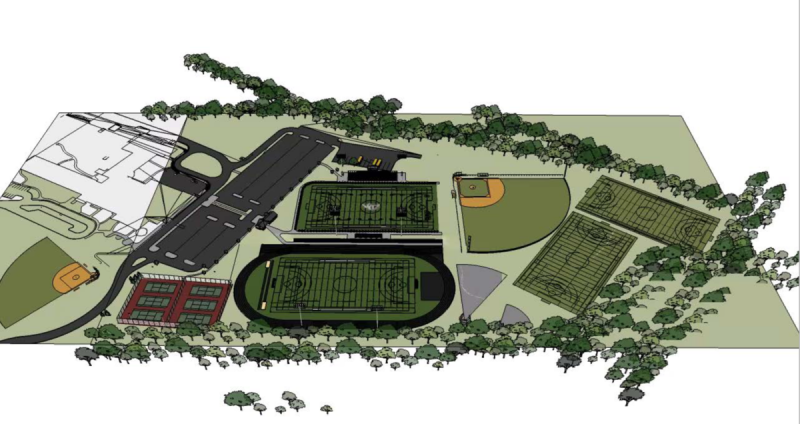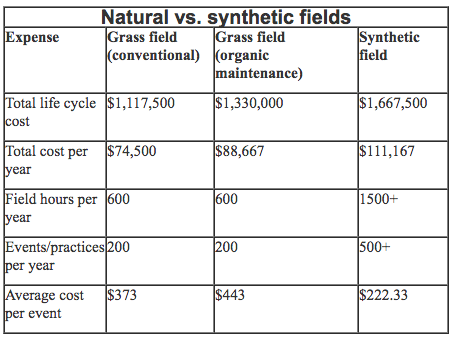Breaking down Old Rochester's athletic complex overhaul
Marion, Mattapoisett, and Rochester Town Meeting voters will be asked this year to approve a $1.67 million per-town cost for overhauling Old Rochester Regional High School's athletic complex.
T.U.R.F. (Tri-Town Unified Recreation Facilities, Inc.) unveiled a $5 million overhaul of the current athletic complex in April of 2017. The project includes a new track, two synthetic fields where the current fields are, and two new natural grass fields, a new athletic building with a concession stand, storage and bathrooms.
The $1.67 million price tag per town could decrease by the time the project goes to a vote, however, as the nonprofit is working to raise funds through private donations.
The stadium field will cost $1.7 million, while the track and secondary field will cost $2.1 million. Both fields would be converted to synthetic turf, while the remaining fields would be irrigated and reseeded. The two new fields, the baseball field and the softball field at the front of the school will cost an estimated $285,000.
The total cost for the new athletic building is projected at $395,000.
At a public meeting on August 17, T.U.R.F. members answered questions about the project. Here's a recap of the discussion.
1. How did the fields fall into such disrepair in the first place?
"It's not a blame game," Flynn said. "The real issue is that with all of the school and youth sports played on the fields, they get 900 hours of use per year. Natural grass maxes out at 600 hours per year. It can't survive the current need that we have."
He added that there are very few other playing fields within the tri-towns, leading to the majority of sports being played at the school fields, whether as a school sport or not.
2.Why not just plant more grass seed?
"We've heard this question before," said T.U.R.F. Secretary Shaun Walsh. "The honest answer is, doing that is a money pit. You can plant as much grass seed as you like — it can't cover the fact that we've gone far over the maximum number of hours that the grass can handle."
3. Why does the track need to be replaced as well?
According to T.U.R.F member Hal Rood, the track is reaching the end of its useful life. Due to its impending demise, as well as the fact that it isn't an eight-lane track approved for state events, he explained that it made sense to lump it into the project as well.
"We can't host state events like finals here without a state-approved track," he said.
4. Why use artificial turf, instead of natural grass?
"I like natural grass," Rood conceded. "When I first joined T.U.R.F., I was pushing for natural grass fields. That just isn't possible with the current use rates."
He pointed out that synthetic turf fields can handle many more hours of use per year than natural grass fields. "The honest truth is that, with our current use rates, we would need to put in six natural grass fields to gain the same amount of hours that only two artificial turf fields can handle."
A natural grass field can handle about 600 hours of use per year, or about 200 events and practices. Synthetic turf, on the other hand, can be used for over 1,500 hours per year, or over 500 events or practices per year.
5. Will the athletic complex overhaul bring in revenue? From where?
According to T.U.R.F, yes — Flynn said that $3,000,00 over 15 years is a conservative estimate. The numbers average out at about $200,000 in revenue per year. He noted that the estimates had been gauged by comparable prices charged by places like Tabor Academy and Taunton High School.
"Right now, we can't host finals or playoffs," he said. "Every time you go to one and fork over $5, guess where that money is going? To the hosting school. This is a chance for ORR to be the hosting school."
Rood said that there were any number of teams who'd like to use the fields. "We have a flurry of youth and amateur leagues popping up," he said. "Plus the number of outside leagues who would want to use the facility for games."
He added that he hadn't talked to a large number of leagues yet, but of the ones he had spoken to, most had been highly interested in the possibility of T.U.R.F.'s proposal. Global Premier Soccer, which according to Rood is one of the larger Massachusetts soccer leagues, was a key supporter. "They told me it was a no-brainer – they'd absolutely use the fields," he said.
6. Where would the generated revenue go?
The ultimate direction of the generated revenue has yet to be decided. "It's part of the selectmen's decision when they consider this project," Rood said, "and that will be part of their decision."
There are three options: put the generated revenue towards the debt incurred by building the compled, holding the money in reserve, or holding the money to finance field replacement. According to Rood, the average lifespan of an appropriately-used turf field is 15 years.
7. Why not scale the project back to make it more affordable?
Use rates, said Rood. "If we only put in one synthetic turf field, we still aren't able to host state and outside events, because there won't be enough room or time. So the revenue generation would at least be cut in half, and we wouldn't end up saving much."
With two synthetic turf fields, one of the natural grass fields can be rested every season — the rest should ensure that the field is used sparingly enough to avoid deterioration.
8. What are some of the benefits for athletes on the fields?
"I've seen too many torn ACL ligaments," said Rood. "The ground is so compressed and so dangerous to play on that hitting the body, or especially the head, against it could cause real damage. There should be some cushion there."
Old Rochester teacher Lauren O'Brien (also a field hockey coach) noted that some college sports teams won't even consider looking at a player who has only played on natural grass. A college field hockey player herself, she explained that playing on the two different surfaces was like night and day.
"Because most colleges wouldn't even look at my tape on natural grass, I had to go join a club league to make them look at me," she said. "I didn't even really want to do that, but I had no choice if I wanted to get on the team."
9. Are there other benefits of building a new sports complex and fields?
The answer is yes, according to Rood. "I've spoken to the United States Realtors Association, and they've unequivocally told me that house values would rise as a result of this project being constructed."
10. What happens if this project is denied by voters at Town Meeting?
According to Rood, the field is in bad enough shape that playing could shortly be suspended on it anyway. "At any moment, an official could walk onto these fields and declare them unsafe for players," he said. "Then nothing can be played there until everything is approved by the officials again. That means at some point, something is going to have to happen. The repairs are needed," he continued. "We should be getting on them sooner, rather than later, for the good of the kids playing on those fields."












